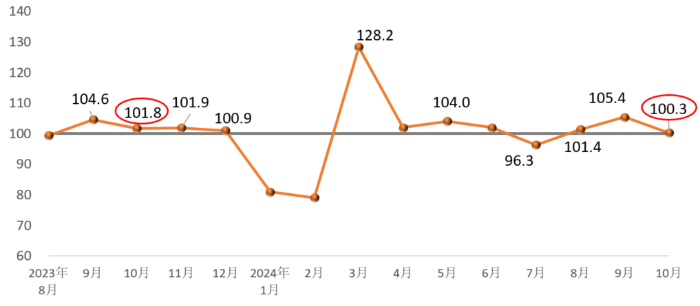1. Building Materials Industry Prosperity Index for October
In October 2024, the Building Materials Industry Prosperity Index reached 100.3 points, a 5.1-point decrease from September and 1.5 points lower than the same period last year. Although slightly above the threshold, it reflects a weak prosperity range, with steady economic performance.

Supply Side
The price index surpassed the threshold at 100.7 points, up by 0.5 from the previous month, while the production index fell to 99.6, down by 5.6. Overall, prices rose month-on-month, but production slowed.
Demand Side
Investment demand and international trade indices remained above the threshold, while the industrial consumption index was slightly below. Specifically:
The investment demand index hit 100.4, a 5.4-point drop, indicating that market recovery is decelerating.
The industrial consumption index fell to 99.6 points due to weakened demand in related manufacturing sectors.
International trade reached 103.5, increasing by 6.1 points, highlighting a positive export effect for building materials.
Overall, demand in October showed a moderate adjustment with new and old dynamics transitioning, and industry stability.
2. MPI Influencing Factors and Warnings
Stable Production
October's production remained stable, with no major fluctuations. Seven sub-sectors, including cement, concrete, wall materials, lightweight materials, mineral fibers, sanitary ceramics, and non-metallic minerals, saw production index increases, notably lightweight materials.
Price Increase
While supply-demand dynamics adjusted with no significant improvements, products in six sub-sectors—cement, concrete, waterproof materials, limestone, building stones, and technical glass—saw slight price increases.
Macroeconomic Environment
Recent macroeconomic policy packages covering monetary, fiscal, investment, and real estate are expected to support the building materials industry’s environment. However, the current supply-demand balance remains weak, with uncertainties. Energy supply is anticipated to tighten in the coming winter, while increased costs in coal and transport (gas, water, and road freight) may impact operational expenses.
3. 2024 Building Materials Industry MPI Adjustment
Demand Side
Investment Market: Building materials investment demand index was 89.5 points, weakened by continued risk management policies and real estate market adjustments.
Industrial Consumption: The industrial consumption index was 100.1 points, with slower growth in key demand sectors such as automotive, solar cells, and home appliances.
International Trade: The trade index was 93.5 points, influenced by historical highs and adjustments from the previous years.
Supply Side
Production: The production index reached 97.8 points, with weaker production for bulk materials like cement and cement products despite steady growth in technical glass and composite materials.
Prices: The 2024 industry price index was 94.2 points, reflecting intensified competition and weakened price support.
Overall, 2024 exhibited weak demand, low supply, and subdued prices, with the adjusted annual MPI at 92.2 points. Prospects for 2025 suggest a stabilized investment demand, steady industrial consumption, and moderated decline in trade, with MPI likely to rebound.
Annotations:
1. Building Materials Industry Prosperity Index (MPI)mainly monitors the operation trend of building materials industry and has a strong function of prediction and early warning. When MPI is higher than 100, it indicates that the operation of building materials industry is in the prosperity range, and when MPI is lower than 100, it indicates that in the recession range.
2. The prosperity index of building materials industry (MPI) judges the operation trend of building materials industry from the supply side and demand side. The supply side is divided into price index and production index. The demand side is divided into investment demand index, industrial consumption index and building materials international trade index according to the actual impact of the demand field on the building materials industry.
3. The price index of building materials industry reflects the change trend of ex-factory price of building materials industry. The ex-factory price does not include the expenses, product profits and taxes incurred in the circulation of building materials products. The ex-factory price is different from the market price, for the changes of the two will affect each other and there is a time lag. There may be inconsistent change trends in a certain period of time.
4. The industrial production index of building materials reflects the change trend of industrial production of building materials, excluding price changes.
5.Investment demand index, reflecting the change trend of investment market demand related to building materials.
6.The industrial consumption index reflects the changing trend of industrial consumption demand related to building materials. Industrial consumption includes not only the internal and inter industry consumption of building materials industry, but also the consumption of building materials products by downstream industries.
7.The international trade index of building materials reflects the changing trend of international trade in building materials, which is mainly composed of export indexes of building ceramics and sanitaryware, building technology glass, building stone, glass fiber and composite materials, non-metallic minerals and other industries.
Editor: Zhang Hanwen
Reviewer: Shen Yulu, Yi Zhanhong




